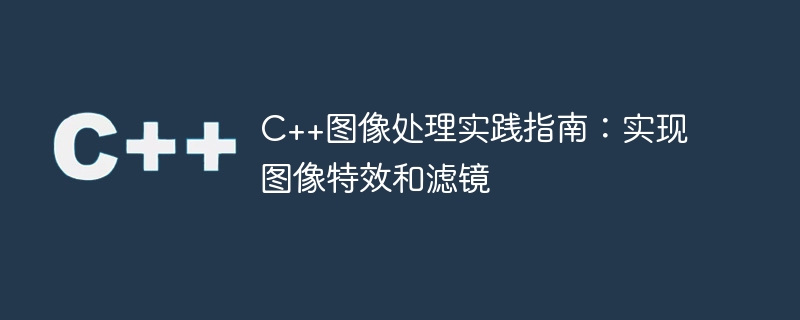Home >Backend Development >C++ >C++ Image Processing Practice Guide: Implementing Image Special Effects and Filters
C++ Image Processing Practice Guide: Implementing Image Special Effects and Filters
- PHPzOriginal
- 2023-11-27 11:40:591881browse

In the fields of computer science and image processing, C has always been one of the most commonly used programming languages. Image processing is one of the important subfields of computer vision, including image analysis, processing and recognition. This article will introduce some basic concepts and techniques in C image processing, and provide some sample codes for implementing image special effects and filters to help readers better understand and practice C image processing.
1. C Basics of Image Processing
1.1 Commonly used image file formats
In image processing, we usually need to use various image file formats, including BMP, JPEG , PNG, GIF, etc. It should be noted that when processing these files in C, you need to use related libraries, such as OpenCV (an open source computer vision library) or ImageMagick (an open source software suite for image processing).
1.2 Pixel
In digital image processing, the most basic unit is pixel. A pixel is the smallest unit in an image, and each pixel can be identified as a value or a set of values. The RGB (Red, Green, Blue) color model is a very common pixel representation. In the RGB model, a pixel is composed of three basic colors.
1.3 Image scaling
Image scaling is a basic operation in image processing. In C, scaling images can be achieved through various built-in functions (such as OpenCV’s resize, etc.). In addition , you can also manually sample a part of the pixels from the original image to achieve image scaling.
2. C Image special effects implementation
2.1 Grayscale
Grayscale is a process of converting color images into black and white images. The pixels in the image only contain grayscale information. In C, grayscale can be obtained by weighting the average of the three components of RGB color values (R, G, B), where R, G, and B represent the intensity of red, green, and blue respectively. Different weight values can Get grayscale images with different effects.
2.2 Color Inversion
Color inversion is a process of converting the original image into its opposite color by inverting all pixel values in the image. In C, color inversion can be achieved by differing the pixel value from the maximum pixel value (255 for 8-bit images).
2.3 Histogram Equalization (Histogram Equalization)
Histogram equalization is a technique that enhances image contrast and brightness by redistributing the frequency distribution of image pixel intensity values. In C, histogram equalization can be achieved by calculating the grayscale histogram of the image and normalizing it.
2.4 Edge Detection
Edge detection is a technology that detects edges in images. It is generally believed that edges are caused by changes in brightness or color. In C, common edge detection algorithms include Sobel, Prewitt, Roberts and other algorithms, which can be implemented by customizing the convolution kernel.
3. C Image Filter Implementation
3.1 Gaussian Blur
Gaussian Blur is a common image filter method, which blurs the image Processing to reduce image noise while retaining the structural information of the image. In C, Gaussian blur can be achieved by using a Gaussian convolution kernel.
3.2 Sharpening
Sharpening is a technique that improves the clarity of an image by enhancing the edges in the image. In C, sharpening can be achieved by blending the original image with a Gaussian blurred image.
3.3 Special effects overlay (Overlay)
Special effects overlay is a technology that applies multiple filters to the same image. It is usually used to achieve various special effects, such as brown, red , nostalgia, etc. In C, special effects stacking can be achieved by applying each filter to the image and stacking them together.
Summary
C Image processing is a very challenging task, which requires developers to be proficient in various basic image processing knowledge and technologies, and also have good knowledge in code implementation. programming ability. This article introduces some common C image processing technologies and practical methods, hoping to help readers understand and practice C image processing. At the same time, readers can also further improve their C image processing skills by reading relevant books and participating in open source projects.
The above is the detailed content of C++ Image Processing Practice Guide: Implementing Image Special Effects and Filters. For more information, please follow other related articles on the PHP Chinese website!

